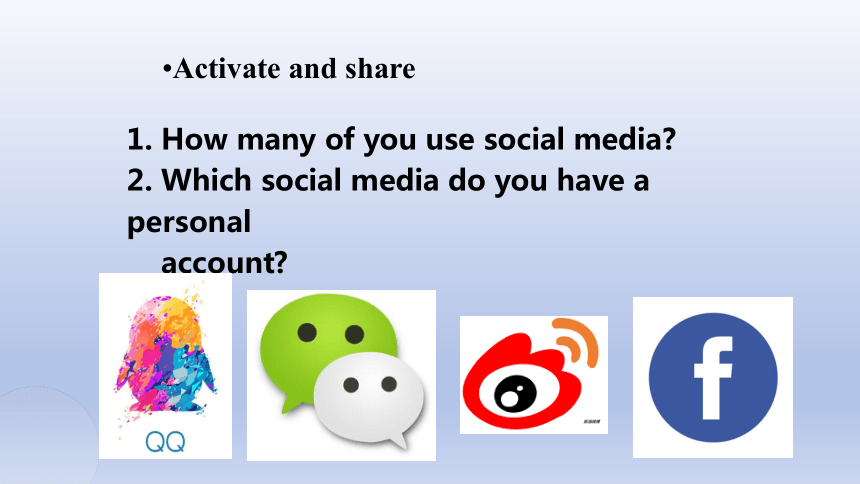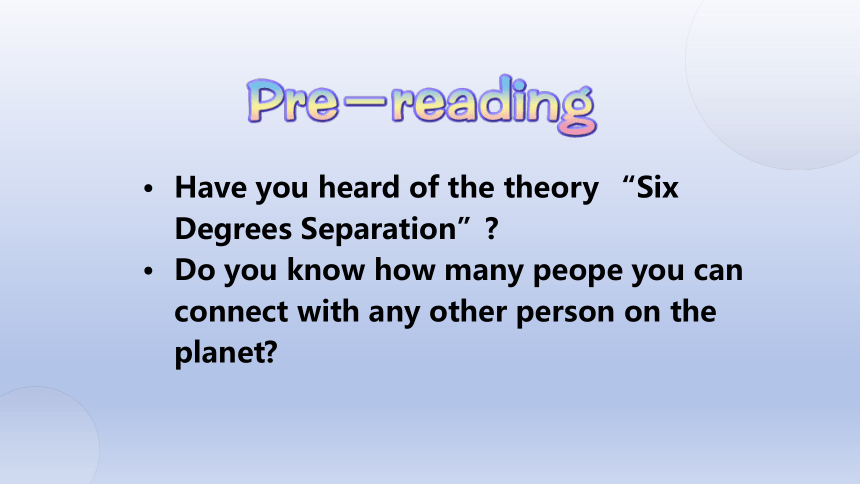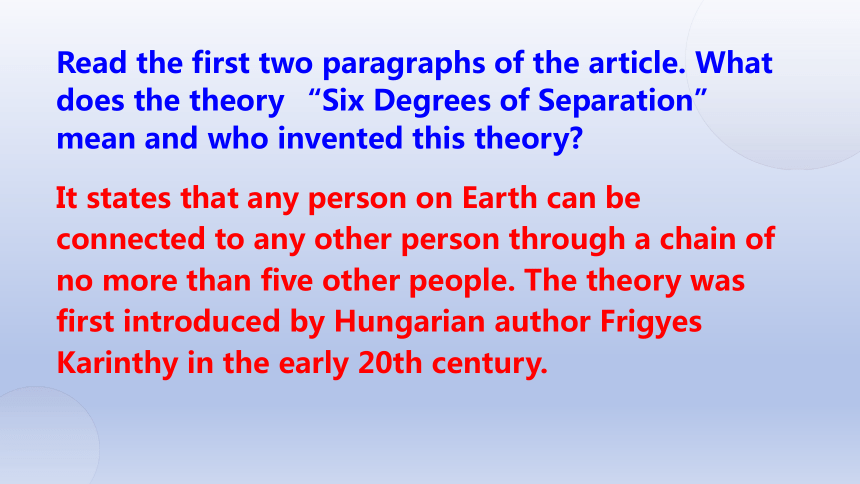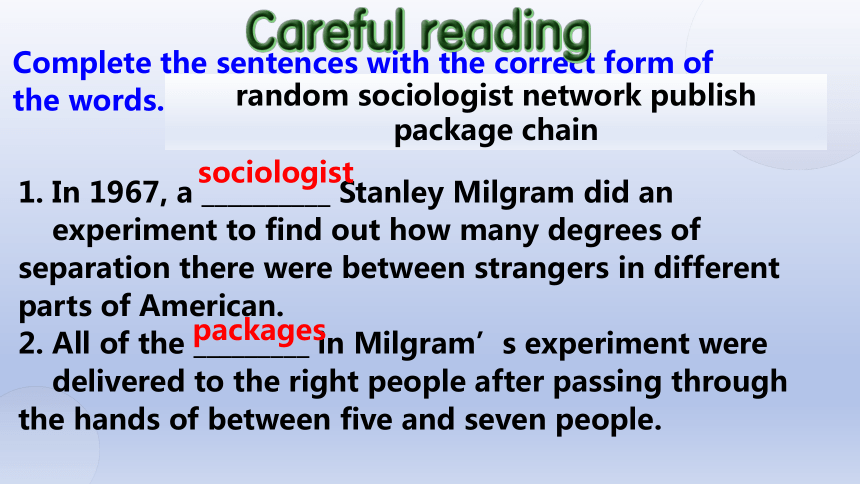选择性必修第四册 Unit10 Connections Lesson 1 How Closely Connected Are We?精品课件(共20张PPT)
文档属性
| 名称 | 选择性必修第四册 Unit10 Connections Lesson 1 How Closely Connected Are We?精品课件(共20张PPT) |  | |
| 格式 | pptx | ||
| 文件大小 | 2.2MB | ||
| 资源类型 | 教案 | ||
| 版本资源 | 北师大版(2019) | ||
| 科目 | 英语 | ||
| 更新时间 | 2023-03-17 20:28:55 | ||
图片预览









文档简介
(共20张PPT)
Unit 10 CONNECTIONS
Lesson 1 How closely connected are we
1. How many of you use social media
2. Which social media do you have a personal
account
Activate and share
Work in groups and discuss the question.
How many contacts do you have on social media How many people do you regularly communicate with
Have you heard of the theory “Six Degrees Separation”
Do you know how many peope you can connect with any other person on the planet
Read the article and find the main idea.
This article introduces what the theory of “Six Degrees Separation” is and how it develops.
Read the first two paragraphs of the article. What does the theory “Six Degrees of Separation” mean and who invented this theory
It states that any person on Earth can be connected to any other person through a chain of no more than five other people. The theory was first introduced by Hungarian author Frigyes Karinthy in the early 20th century.
Read the rest of the article. Find out about the development of the theory. Take nowts in the table below.
1967 Mid-1990s
Who
How
Findings/ results
Stanley Milgram
He chose a random sample of people in the middle of America and asked them to send package to a stranger in the state of Massachusettes.
It only took between five and seven people to get the parcels delivered.
Two college students in the United States
They invented a game. The idea of the game was to link any actor to Kevin Bacon, a famous American actor and musician, through no more than six links.
The game was being played in universities across the United States.
2003 2011
Who
How
Findings/ results
Columbia University
“Columbia Small-world Project”: Columbia University tried to recreate Milgram’s experiment on the Internet. The experiment involved 24,163 email chains with 18 target people in 13 different countries.
The results confirmed that the average number of links in the chain was six.
the University of Milan
The experiment analysed the relationship between 721 million social media users.
92% were connected by only four stages.
Complete the sentences with the correct form of
the words.
1. In 1967, a __________ Stanley Milgram did an
experiment to find out how many degrees of separation there were between strangers in different parts of American.
2. All of the _________ in Milgram’s experiment were
delivered to the right people after passing through the hands of between five and seven people.
packages
sociologist
random sociologist network publish package chain
3. The results of Milgram’s experiment ______________ in the magazine Psychology Today.
4. The result of the “Columbia Small-world Project” confirmed that the average number of links in the ______ was six.
5. People doing experiments into “Six Degrees of Separation”usually choose a _______ sample of people to take part to make the results more reliable.
6. Recently, creating and growing your social _______ has
become more important than ever before due to the growth of social media.
chain
were published
random
network
Read the article again. Answer the questions.
1. When did the term “Six Degrees of Separation”first appeared
2. What happened in the 1950s
It first appeared in the 1920s.
In the 1950s, an attempt was made by two scientists to prove the theory mathematically.
3. What did Stanley Milgram do
4. What information of the stranger did the people get before they sent the packages in the Stanley Milgram’s test
He tried using a new method to test the theory, which he called “small-world problem”.
They only knew the name, job and general location of the stranger.
5. How many people did it take for the parcel to
reach the right person in Milgram’s experiment
6. How did the theory influence the entertainment industry
It only took between five and seven people for the parcel to reach the right person in the experiment.
First, its name was used as the title of a play and a film. Then, more films and TV programmes were produced and broadcast on the basis of the concept.
7. What is the “Columbia Small-world Project”
8. What was the result of Columbia University’s
experiment
Columbia University recreated Milgram’s experiment on the Internet in 2003, which was known as the “Columbia Small-world Project”.
The average number of links in the email chain was six.
9. What was the result of the University of
Milan’s research
Of the 721 million social media users, 92% need only go through four stages (i.e. five degrees of separation) to establish a connection.
1 Why did Milgram and Columbia University
both label their experiments “Small world”
Because they believed that any person on Earth could be connected to any other person through a chain of no more than five other person. In this sense the world is small.
Think and share
2 Why do you think people study how people are connected
Probably people want to study the structures of human society, the rules of human social activities, and how people are connected with each other.
Discuss and decide what experiment you can carry out to find out how many degrees of separation there are between people who don’t know each other. Consider:
how many people will participate in the experiment
what will the participants do
how will you find out the results of the experiment
Search online and find details about the “small-world problem”, “Columbia Small-world Project” or other experiments related to the theory. Write a short report on your findings.
Thank you
Unit 10 CONNECTIONS
Lesson 1 How closely connected are we
1. How many of you use social media
2. Which social media do you have a personal
account
Activate and share
Work in groups and discuss the question.
How many contacts do you have on social media How many people do you regularly communicate with
Have you heard of the theory “Six Degrees Separation”
Do you know how many peope you can connect with any other person on the planet
Read the article and find the main idea.
This article introduces what the theory of “Six Degrees Separation” is and how it develops.
Read the first two paragraphs of the article. What does the theory “Six Degrees of Separation” mean and who invented this theory
It states that any person on Earth can be connected to any other person through a chain of no more than five other people. The theory was first introduced by Hungarian author Frigyes Karinthy in the early 20th century.
Read the rest of the article. Find out about the development of the theory. Take nowts in the table below.
1967 Mid-1990s
Who
How
Findings/ results
Stanley Milgram
He chose a random sample of people in the middle of America and asked them to send package to a stranger in the state of Massachusettes.
It only took between five and seven people to get the parcels delivered.
Two college students in the United States
They invented a game. The idea of the game was to link any actor to Kevin Bacon, a famous American actor and musician, through no more than six links.
The game was being played in universities across the United States.
2003 2011
Who
How
Findings/ results
Columbia University
“Columbia Small-world Project”: Columbia University tried to recreate Milgram’s experiment on the Internet. The experiment involved 24,163 email chains with 18 target people in 13 different countries.
The results confirmed that the average number of links in the chain was six.
the University of Milan
The experiment analysed the relationship between 721 million social media users.
92% were connected by only four stages.
Complete the sentences with the correct form of
the words.
1. In 1967, a __________ Stanley Milgram did an
experiment to find out how many degrees of separation there were between strangers in different parts of American.
2. All of the _________ in Milgram’s experiment were
delivered to the right people after passing through the hands of between five and seven people.
packages
sociologist
random sociologist network publish package chain
3. The results of Milgram’s experiment ______________ in the magazine Psychology Today.
4. The result of the “Columbia Small-world Project” confirmed that the average number of links in the ______ was six.
5. People doing experiments into “Six Degrees of Separation”usually choose a _______ sample of people to take part to make the results more reliable.
6. Recently, creating and growing your social _______ has
become more important than ever before due to the growth of social media.
chain
were published
random
network
Read the article again. Answer the questions.
1. When did the term “Six Degrees of Separation”first appeared
2. What happened in the 1950s
It first appeared in the 1920s.
In the 1950s, an attempt was made by two scientists to prove the theory mathematically.
3. What did Stanley Milgram do
4. What information of the stranger did the people get before they sent the packages in the Stanley Milgram’s test
He tried using a new method to test the theory, which he called “small-world problem”.
They only knew the name, job and general location of the stranger.
5. How many people did it take for the parcel to
reach the right person in Milgram’s experiment
6. How did the theory influence the entertainment industry
It only took between five and seven people for the parcel to reach the right person in the experiment.
First, its name was used as the title of a play and a film. Then, more films and TV programmes were produced and broadcast on the basis of the concept.
7. What is the “Columbia Small-world Project”
8. What was the result of Columbia University’s
experiment
Columbia University recreated Milgram’s experiment on the Internet in 2003, which was known as the “Columbia Small-world Project”.
The average number of links in the email chain was six.
9. What was the result of the University of
Milan’s research
Of the 721 million social media users, 92% need only go through four stages (i.e. five degrees of separation) to establish a connection.
1 Why did Milgram and Columbia University
both label their experiments “Small world”
Because they believed that any person on Earth could be connected to any other person through a chain of no more than five other person. In this sense the world is small.
Think and share
2 Why do you think people study how people are connected
Probably people want to study the structures of human society, the rules of human social activities, and how people are connected with each other.
Discuss and decide what experiment you can carry out to find out how many degrees of separation there are between people who don’t know each other. Consider:
how many people will participate in the experiment
what will the participants do
how will you find out the results of the experiment
Search online and find details about the “small-world problem”, “Columbia Small-world Project” or other experiments related to the theory. Write a short report on your findings.
Thank you
同课章节目录
- Unit 10 Connections
- Lesson 1 How Closely Connected Are We?
- Lesson 2 Community Spirit
- Lesson 3 Anne of Green Gables
- Unit 11 Conflict And Compromise
- Lesson 1 Living In a Community
- Lesson 2 Dealing with Conflict
- Lesson 3 War Memories
- Unit 12 Innovation
- Lesson 1 Scientific Breakthroughs
- Lesson 2 Aha Moment
- Lesson 3 Stephen Hawking
